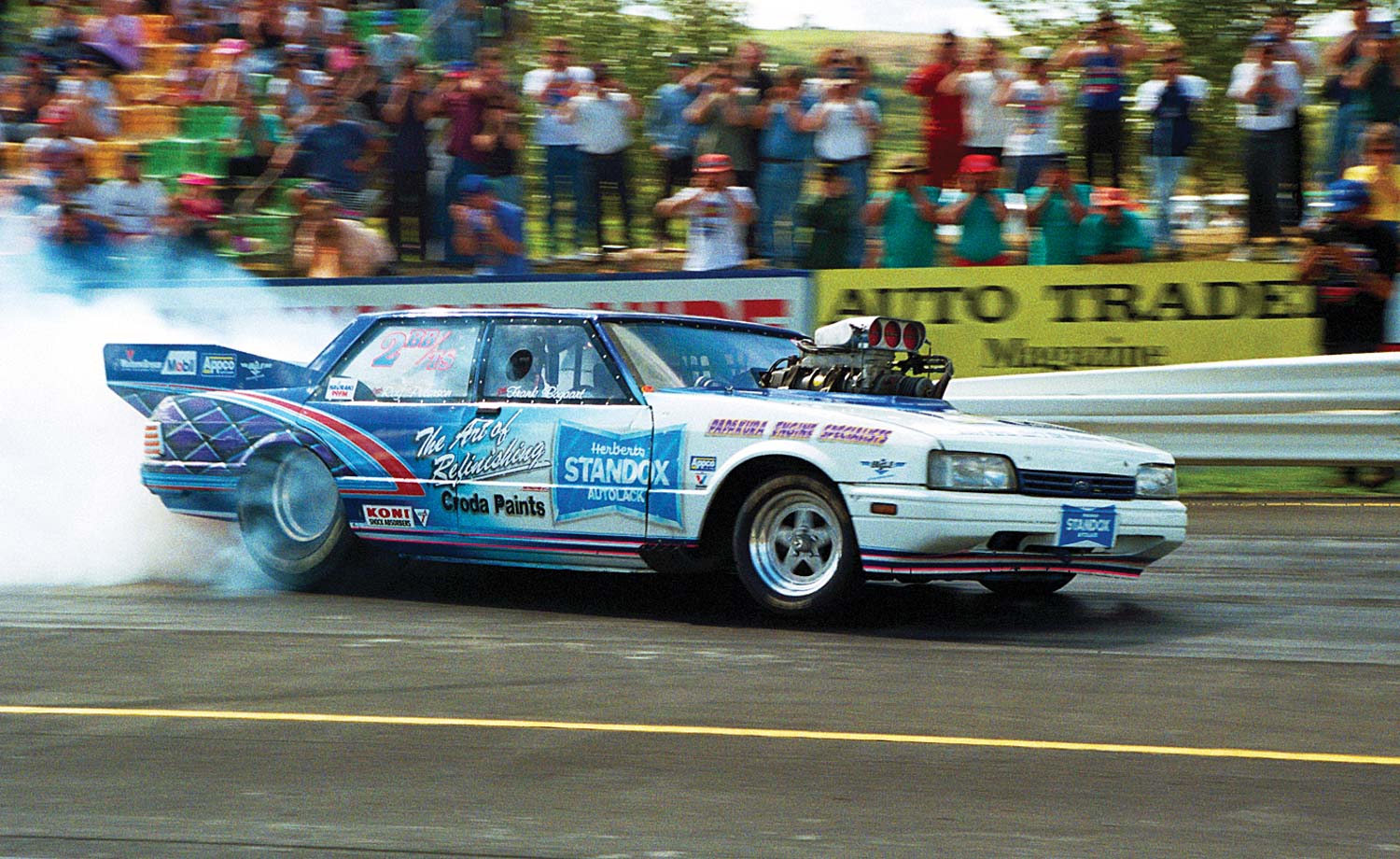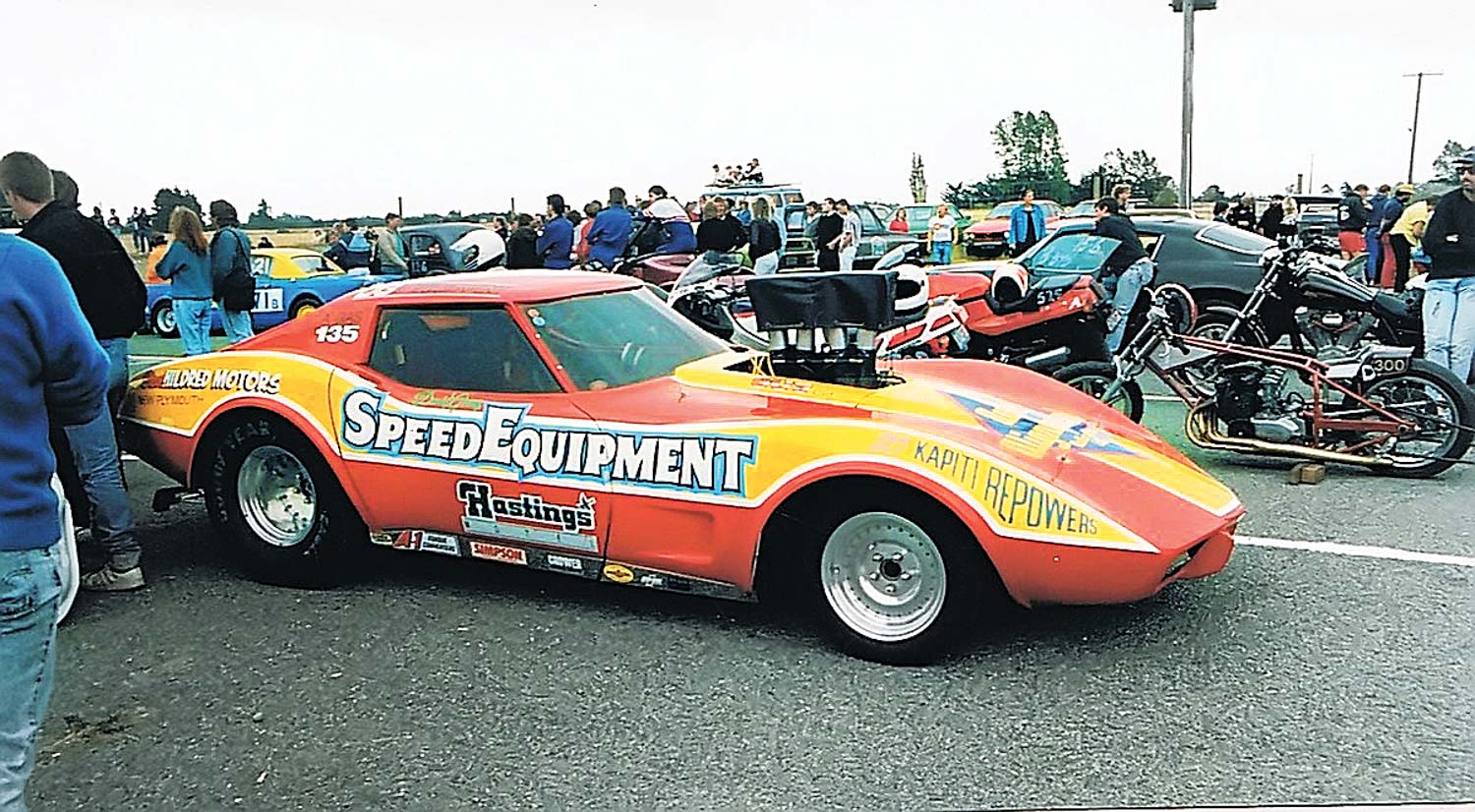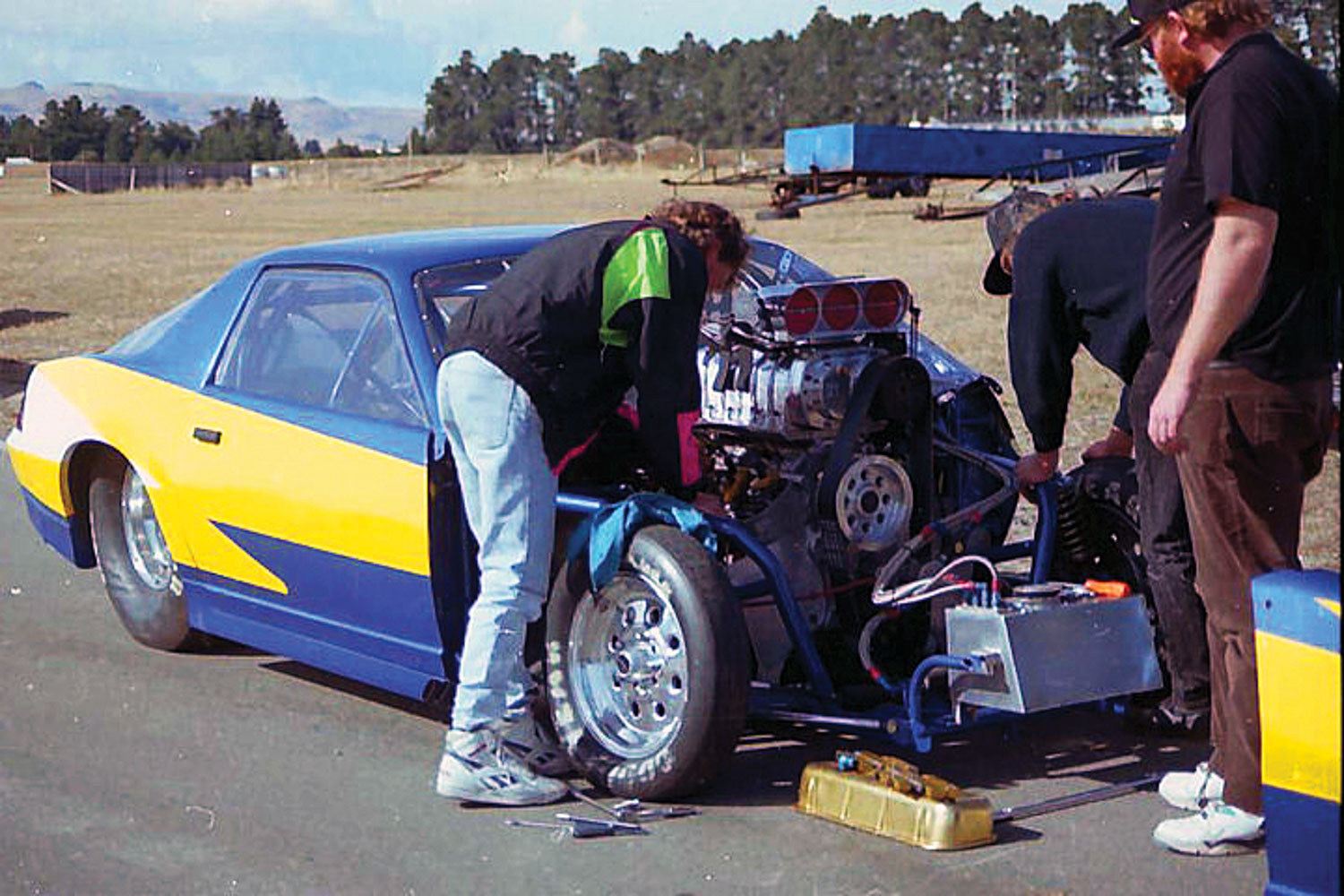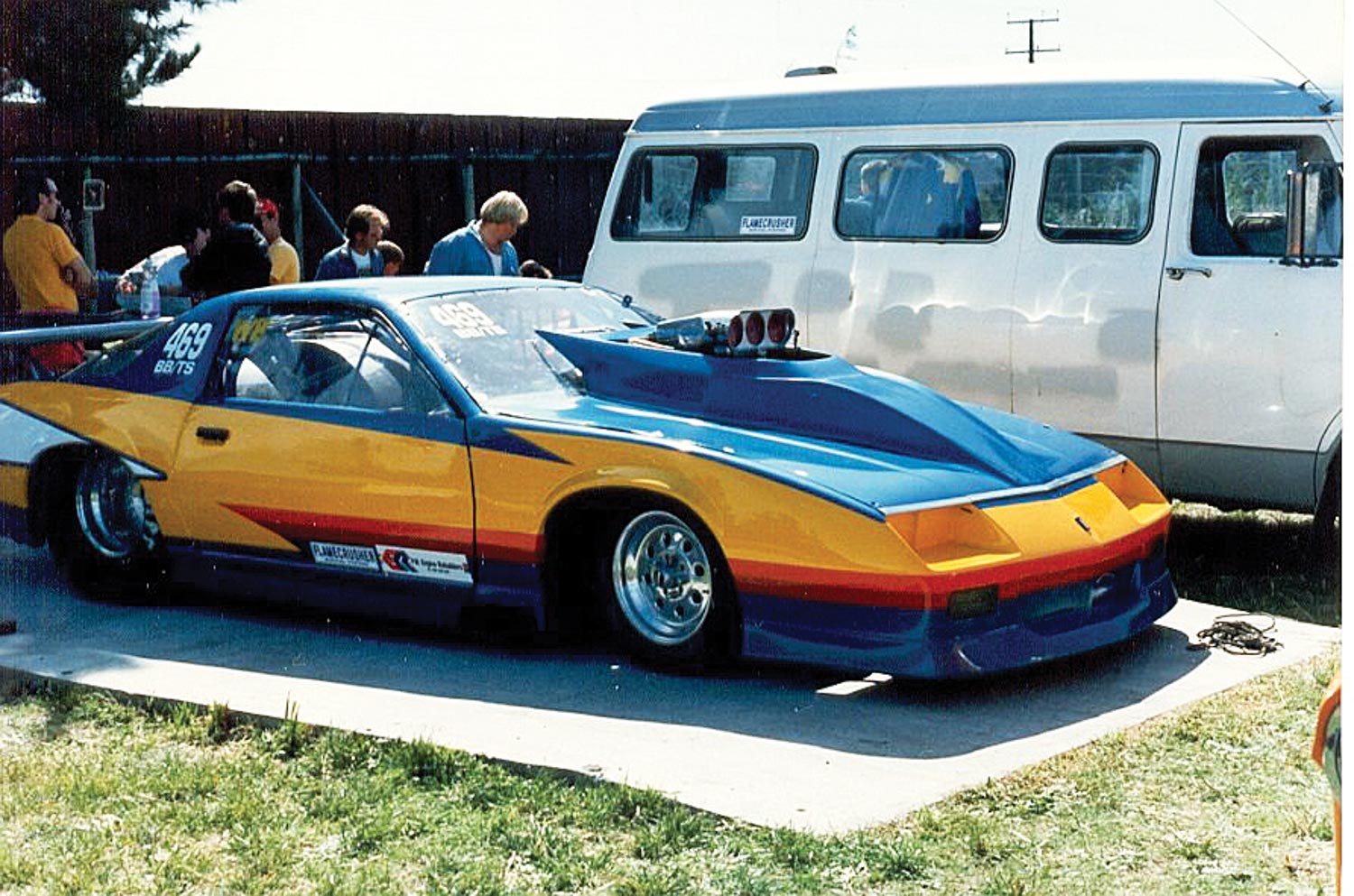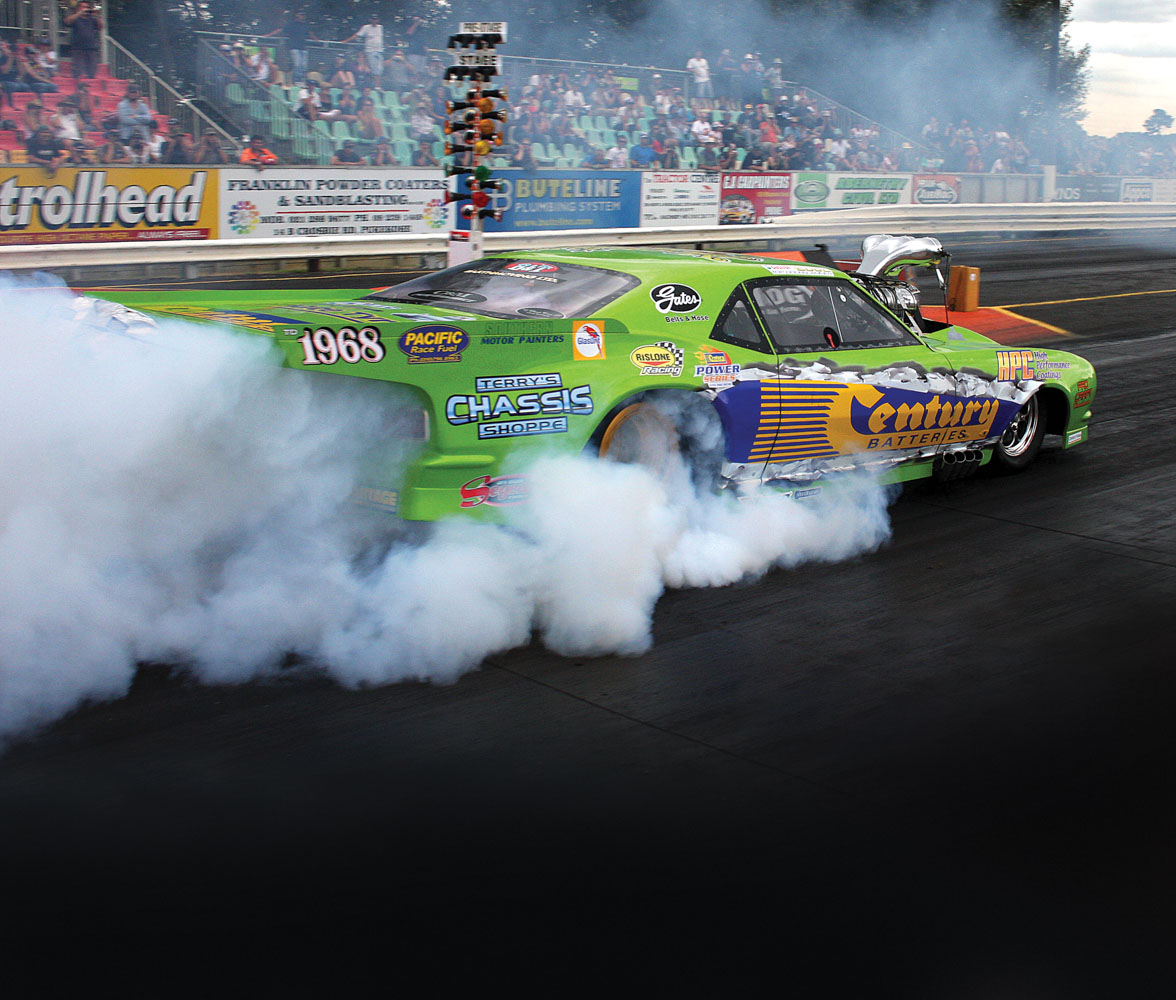data-animation-override>
“With New Zealand’s most prolific doorslammer recently celebrating 30 years of competition, we thought it was about time to look back and see how slammer racing evolved to the spectacle that it is today. In the last two weekends we started looking at the well-known names in New Zealand doorslammer racing. Here is the third and final part of the story”
Click here to check out part one, or here to check out part two.
Trevor Smith, 1975 Holden Statesman, 2007–present

A similar story can be told a dozen or more times when we talk of the evolution of race cars in this country, and Trevor Smith and the big yellow Statesman fits with the standard scenario. Started as a street car, been cut, welded, then cut, rejigged and welded-up again, upgraded and morphed into what you see today, it’s a familiar story and one that defines not only the race car but the man himself and his ongoing vision.
Trevor’s story started earlier than most — metallic brown with the vinyl roof popular in that era, the car originally belonged to an uncle, passed through a friend and onto Trev’s dad long before Trev ever got his hands on the steering wheel. Once he did though, it wasn’t long before the much-loved sedate street cruiser was set on a path that would lead it to the smoke-bellowing, blown, injected slammer that can be seen tearing up the tarmac during the country’s all-too-short summer months.
Instrumental in the transformation would be Terry Bowden of Terry’s Chassis Shoppe; he was the one who completed the fab work on the first ‘tub’ job, through the first full chassis build and a myriad of changes and upgrades, and as you read this is even at it again, with grinder and TIG torch upgrading the rear end of the car.

Starting with a basic naturally aspirated small block Chev the Statesman was tough but it wasn’t until lots of original sheet metal was replaced by lighter fibreglass versions, and the addition of a dose of laughing gas, that the nine-second range would be mastered, dipping as low as 9.3. The Top Street bug had well and truly bitten and the BB/TS marks were where the yellow beast was headed next. A new chassis was constructed by the aforementioned Mr Bowden, with a four-link rear and a bunch of other go-fast goodies also added to the mix. The 14/71 blown and injected Chevy donk, so dominant up front, looks like it was meant to be there, and the classic lines of the Statesman remain, no over-the-top aerodynamic, swoopy front, cutting or wedging, just the gigantic rear wing that you could land a helicopter on to keep her stable at the ever increasing top-end speeds.
A first-up early click of 8.90 was quicker than he had gone before and the start of an all-new love affair with the car. With more than double the horsepower of the previous version, the learning curve was steep, but it was tackled with ease. The ETs have since dropped drastically and the top-end numbers increased to bests in the 7.20/190mph range, and with yet more Bowden magic being undertaken one can bet Big Trev and the even bigger yellow Statesman will soon be joining the six-second 200mph club.
David Green, 1976 Corvette, 1987–present

Any fan of the American auto industry is familiar with the iconic Corvette line of vehicles. Stylish and sought after, the Corvette lends itself to a certain type of owner, and many own more than one through their lives and tend to stay loyal to that brand. David Green (DG) fits that stereotype to a T — he has the Corvette street car he cruises around in and although his race car is also a ’Vette there is not a whole lot left on it from what rolled off the production line in 1976.
Originally released with a base model producing around 180hp, DG’s incarnation now produces well over 10 times that amount, a natural progression like so many others in the class. DG is not just the man behind the wheel, his racing career is defined by all he’s also done away from the track: he builds his and other racers’ engines, sources parts and components from stateside or builds them himself. He has built all his own chassis and those of several other racers, and the ’Vette would probably be seen more often if he wasn’t always busy with other people’s builds. Time management is not DG’s strongest attribute, but impressive timeslips are something he has gathered many of over the years.

Originally painted a red hue when it first appeared with a stack-injected iron block Chev and Powerglide, it was competitive from the get-go, running mid nines while hooking the front high on the launch. With a switch to an aluminium block and heads, the ’Vette, while not initially trouble-free, soon enough was more than competitive against the blown cars of the era and a hell of a lot more consistent. The box section chassis was next for the chopping block and a DG-designed tube frame was soon sitting beneath the now-yellow ’Vette skin. The basis of that same chassis can still be found under the body to this day together with the obvious upgrades as the power has been added. A four-speed Lenco and clutch found its way into the car not long after the new chassis, making the already confined cockpit even tighter, but with plenty of room for DG’s slight frame to make itself comfortable in. With a tunnel-rammed Enderle hat injection set-up the car would run into the low eights, capable of more than an upset or two along the way.

A decision to join the supercharged fray was met with a less than memorable debut. Running a basic blown motor put together for the purpose of familiarization, DG grasped the opportunity to add to the long list of parts created by himself for the car, adding a blower manifold, drive and idler assembly to his many creations. With a certain Mr C Tynan taking the first rides with the blown combo it was with horror that DG saw the now purple ’Vette disappear up over the hill out of sight at the end of the track at Meremere. By the time the team got down there, CT had extracted himself from the car now-so-gracefully parked in the infamous gorse bushes. Luckily both the car and CT were not hurt as such, probably pride was the only thing damaged that day and many lessons were learned on several fronts. It became a whole different animal with blown power: mid sevens were soon clicked off, but it was the closing down of Thunderpark that would lead DG to his first substantial timeout while he concentrated on his business and family life, but he would return stronger than ever before.

When he did, it would be with an all-new power plant, a 481X as they are affectionately known, DG’s example is one of very few of the Rodeck variants ever made before Alan Johnson obtained the castings and made his own ‘Olds’ variant. A hybrid with a Chevy top-end and Chrysler bottom-end design, the 481X topped off with a set of massive EPD cylinder heads and 14/71 supercharger would help propel the ’Vette deep into the six-second zone and ultimately to claim a national record that had stood for many years.
With the bright-yellow ‘Monster’ paint scheme the ’Vette not only looked like the modern-day American Pro Mod, it was starting to act like one, and once its potential was harnessed, the marks held by Chris Tynan’s ’55 for more than seven years were smashed when the monster ’Vette unleashed a 6.45 at 213mph, numbers never before seen by a Kiwi slammer. He then proceeded to back them up before the meeting was eventually rained out.
While DG and the ’Vette haven’t been seen for a few seasons now while he concentrates once again on his business and constructing a new house, it’s with baited breath that we wait to see what one of Wellington’s most prominent drag racers has in store for us next, and by all reports we won’t have to wait long to find out.
Dave and Chad Tully, 1988 Ford Falcon, 2007–present

Originally campaigned in the late ’80s by Ray Peterson with early iron-Hemi power and later in partnership with Frank Bogaart driving, the Falcon never really reached any lofty heights in the early Wild Bunch days. A solid eight-second campaigner, it was always a little down on horsepower and set-up compared to others in the class, but nevertheless with Frank as the shoe, wild-foot-to-the-floor burnouts were always on the cards.

Father and son Dave and Chad Tully purchased the roller in 2007 after previously having pedalled a super gas ’36 Dodge coupe. The coupe was fun and consistent, the Falcon however was a whole different ballgame and with 509 cubes of supercharged Jim Oddy power — the step up was a big one. To their credit the father-and-son team have equipped themselves well, slowly stepping up the combination as the confidence grew. With bests in the 7.50 range the Falcon is by no means the quickest in the class but with an NZDRA National Championship last season now under their belts, not only do these guys have a ball racing all round the country, they do it within their limitations and are always putting on a show for the blue oval fans.
Tom Richardson, 1957 Chev, 1992–present

Tom Richardson is probably the person you would least expect to have jumped behind
the wheel of a blown slammer, and drag racing definitely takes a secondary role to his life on the farm, but a nicer guy you will never meet. Humble and softly spoken, Tom’s entry into our little take on the history of these type of vehicles comes from the photo shown here, and snapped by Mike Ashton (www.dragpixs.co.nz). Quite simply it has to be the most impressive wheelstand in the class’s history. That day at Thunderpark, the car’s chassis builder, Chris Tynan, had, from memory, made a few ‘adjustments’ for Tom prior to the run and could be seen grinning from ear to ear shortly after the shot was taken. Tom still has the car and will probably never sell it, last time out a few years back it wounded an engine and I’d imagine that’s how it sits these days. No doubt Tom and his lovely wife, and only crew-member, Peg, will venture out again at some point, but when that is I doubt Tom even knows.
Wayne Yearbury, 1953 Studebaker, 2006–present

The name Yearbury has been synonymous with Group 1 racing in this country for decades, generally at the pointy end of the performance spectrum in a range of different vehicles. Starting in the early ’80s with a big block Chev–powered Top Alcohol dragster, through a series of alcohol funny cars with Hemi power that he raced not only all around the country but also in Australia and even Japan. After selling his last funny car for financial reasons, many thought he would return; I doubt many would have picked it would be behind the wheel of a ’53 Studebaker Top Doorslammer though.

When construction began in 2005 it was done with a Murray Anderson–carbon-fibre bodyshell, with the double-frame rail chassis construction entrusted to a certain Terry Bowden, whose meticulous attention to detail is evident throughout. A Powerlink swingarm rear suspension was sourced from Aus with a bunch of other top-of-the-line parts and a web of chromoly tube was soon stitched together by Terry’s steady hand. With the intention of lifting the bar in the class in New Zealand, the chosen power plant would give Wayne every chance of doing just that. A 526 cube Keith Black Hemi was sourced complete with Veney heads, monster PSI supercharger and an MSD 44-amp ignition to light the fire.

Chipping away at the set-up, initially it wouldn’t take long for Yearbury and the Stude to drop into the sixes and prove one of the toughest cars in the modern era of slammer racing. While it was Dave Green in the ’Vette to finally take Chris Tynan’s long-standing record, and not the Stude as many predicted, it wouldn’t take Wayne long to ultimately claim the national record for himself, which today stands at 6.437 seconds. The Wayco Studebaker has run as fast as 6.30, second only to Tynan’s 6.22 as the quickest pass in New Zealand Slammer History.
One of the true purpose-built, modern-day Kiwi Top Doorslammers, the car may not have the history of others but on the performance side of things the Stude is among the best the country has seen.
Shadwick Bros, Mark Bardsley, 1968 Chev Camaro, 1994–present

Probably one of the most common body styles in Pro Mod and Top Doorslammer racing these days, the first generation Camaro lends itself to the job perfectly, with gracious rounded lines, narrow track and low-slung ride height, it’s no wonder they are so popular and New Zealand’s finest example these days belongs to Mark Bardsley, but it was originally skilfully crafted by Bruce and Alan Shadwick of Al’s Blower Drives fame.
Initially, the car had been imported from the States by Mike Nola and purchased by the Shadwicks, back-halved and basically gutted. With the intention of using what they had, plans soon changed and all that remained was the roof and rear quarters by the time the carve-up was complete. With the late Steve Brown’s passing, a partially tack-welded chromoly frame became available from under the ’55 skin that had subsequently come into the hands of Craig Brown. The frame was disassembled and the same chromoly tube was used to form the skeleton beneath the Camaro shell that you can see to this day. With the roof chopped and the screen laid back, the Shadwick’s themselves handled all the fibreglass and tin work and the million-and-one other bits and pieces that go into producing a modern day work of art. With the likes of Terry Sims and Dave Tollemache chipping in with the more technical metalwork the ’68 was soon ready for a power plant.

A 358ci SBC Rodeck with -11 Brodix heads, Mooneyham 8-71, Enderle Bird Catcher and a Lenco four-speed transmission with a Crower 10-inch pedal clutch were soon inserted and the Shadwicks now had one of the most impressive Kiwi-built cars ever seen.
On the racetrack the Camaro was just as impressive, as the little screaming small block charged into the seven-second zone with bests of 7.46 at 181mph. The small block was tough, in winning Wild Bunch at the ’98 Nationals the little block ran three passes with two broken piston pins. Al did notice something weird that didn’t look like bearing material in the system but it wasn’t until a tear-down after the meet that that the source was found.
A year or so later the car would have a new owner — Mark Bardsley — who still owns the basis of what was the Shadwick Slammer to this day. Originally purchased as a roller, the SBC Rodeck was soon also in Bardsley’s hands when plans of big block power were shelved as there was simply nothing available for the price the little beast was offered for. When the car did reappear with Mark behind the wheel it was hardly recognizable from the one that was previously raced in a basic white hue, a stunning green Predator-themed paint job now made the car stand out even more than before, and Mark was quickly up to speed with more ponies at the end of his right foot than ever before. Being almost instantly competitive, the battles with Craig Brown’s big block ’55 were always exciting, unfortunately for Bars the sky blue ’55 driving around him in the deep was an all too common sight.

With a BB/TS record at 7.36 in 2005, Bars soon decided that more power was needed and a deal was stuck via Dave Green to purchase a new combo. A 526ci KB olds with massive 14/71 retro high helix supercharger was dropped in and basically the same power plant remains there today.
Soon in the sixes, an opportunity arose to race the car in Australia in 2007, and, after an unexpected swipe with the guard rail, the thrash was on to repair the damage before the Winternationals a few short weeks later. With the help of many, the car was fixed and ran solidly at the Winternats and was soon on its way home again with bigger plans in mind. A carbon-fibre body was imported from the States, with Terry Bowden tasked with mounting it to the existing chassis. Along with Mike Roberts, Terry also created all the new tin work and associated parts that form what you see today. At a mere 75lbs the carbon body can be removed completely from the chassis in a matter of minutes and Bars’ Camaro is now dancing around the mid 6.50 range at well over 200mph.

While the Shadwick’s may have created the initial masterpiece, Mark has done more than his fair share to keep the car at the forefront of Kiwi slammer racing, being the first recipient in 2003 of the NZDRA Award of Merit for his services to drag racing and becoming an NZDRA National champion in Top Doorslammer at the end of the 2007 season. Not only at the racetrack but away from it, the familiar green doorslammer has been seen and enjoyed by many all around the country and one can only hope that trend continues in the years to come.
Robin Silk, 1987 Chev Camaro, 1990–1997

Long before Robin Silk turned up in 1992 with the infamous blue/yellow Camaro that would earn him his place in door car history, he was making laps in everything from the Ford pop-bodied funny car/altered that went by the name of ‘Demon Rattler’ to a series of ill-fated Chevette-bodied Gas-classed rides that were overpowered and ill-handling to say the very least. The Camaro had appeared in partnership earlier with the motor from Euan Mark’s bucket and Castrol sponsorship, after the bucket had been booted out of the Wild Bunch ranks, and although solidly in the eights and among the quicker cars in the bunch the partnership was short-lived and Robin soon had his own combo lined up.
When the blue/yellow version of the Camaro first made an appearance at Ruapuna, not exactly race-ready, it was mid afternoon by the time the thrash to complete the car at the track was over and it rolled through the burnout box under its own steam for the first time. With Tynan in the sevens and pretty much everyone else in the low eight-second range, jaws dropped when on his required ‘bye’ run to license the new car, Robin clicked it off a little after half-track and still rattled off an 8.45 at only 129mph.

Built to race in Wild Bunch, the Camaro initially proved way too light to be classified as a BB/TS car and ran as a BB/A in Super Comp until weight could be added to the supercharged 540-cube Camaro. Within a couple of meetings it was in the sevens and second behind only Tynan running into the 7.60 range.
Unfortunately for Robin he would pay a terrible price for ignoring basic safety rules, rules not enforced anywhere near as stringently as they are today. At a feature Door Slammer event at Thunderpark the Camaro burst into fire a little after half-track, the fireball passed from the engine bay through a large gap in the firewall into the driver’s compartment and Robin suffered second-degree burns to his face and third-degree burns to his hands as a result. Lessons learned from the accident would help to make the sport safer for future racers, and, as unfortunate as it was that we all had to learn from such an incident (and that Robin paid the price for others), it brought about change for the betterment of the sport.

Though the Camaro would reappear and eventually run deeper into the mid seven-second range it would never really have the impact its early outings predicted it might. Today the car sits ready to go in the hands of a new owner whose plans are unknown, although a new track in Masterton just up the road may be just what’s needed to see it once again getting some action trackside.
Photos: NZV8 archive, dragpics.co.nz
This article was originally featured in a previous issue of NZV8. Pick up a copy of the edition here:










